You’ve probably read about the average new vehicle selling for nearly $50,000. How about one for about a third that much?
Chevy makes one like that.
It’s called the Trax.
What It Is
The Trax is a small crossover with a very small asking price – $20,400 for the base trim – that is powered by one of the smallest engines (a 1.2 liter three cylinder engine) ever installed in a car.
The most expensive version of the Trax – the 2RS trim – only costs $23,900.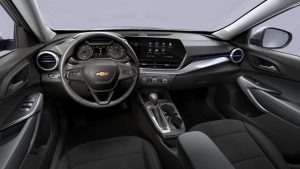
That’s about half what a new Tesla 3 electric car costs. And the Trax can travel about 400 miles on a tank – while the Tesla 3 goes maybe 300 (if it’s not too cold out).
It’s also several thousand dollars less than the price of a similar small crossover such as the Honda HR-V ($24,100 to start) or the Mazda CX-30 ($24,995). These come standard with larger (and stronger) four cylinder engines – but they also cost several thousand dollars more than the Trax.
What’s New For 2024
The Trax is back with a new, larger body – and a smaller engine. Plus more available features – including some you might not expect in an entry-level vehicle, including adaptive cruise control and a heated steering wheel.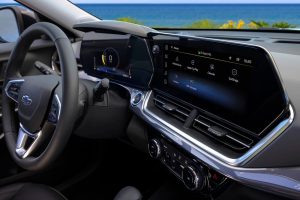
What’s Good
Lower base price than the old Trax.
Much more spacious than old Trax.
Better gas mileage than old Trax.
What’s Not So Good
Smaller three cylinder engine is under a lot of pressure.
All-wheel-drive (which used to be optional) is no longer available.
Standard “assistance technologies” are standard, peremptory and cannot be turned permanently off.
Every Trax comes standard with an engine that’s almost not there (which is where we’re headed as this push to eliminate engines in favor of motors proceeds).
Just three cylinders and only 1.2 liters.
The old Trax came standard with a 1.4 liter four cylinder engine.
Power is down to 137 horsepower (about the same output as the 1200 cc engine that powers this writer’s motorcycle) and torque is just 162 ft.-lbs. at 2,500 RPM. The old Trax’s four made 155 horsepower and 177 ft.-lbs. of torque.
Surprisingly, the new Trax is not slower than the old Trax.
It can get to 60 MPH in about 8.5 seconds, which is quicker by about 1 full second than the old (and more powerful) Trax. Probably because it’s about 150 pounds lighter – which is also surprising because the ’24 Trax is significantly larger than its predecessor.
On the other hand, the Trax’s mileage is surprisingly mediocre. It only manages 28 city, 32 highway – which is about the same (or slightly less) than the mileage delivered by larger-engined rivals such as the Mazda CX-30 (26 city, 33 highway from 2.5 liters, four cylinders and 191 horsepower).
The reason why is because the ’24 Trax – while lighter than its predecessor – is still surprisingly heavy (3,062 lbs.) for something that’s still as small as it is. To get a sense of this, an ’80s-era Chrysler Aries K-car – remember those? – was almost exactly the same length (176 inches) as the ’24 Trax (178.6 inches) but the K-car weighed just 2,414 lbs. Which is the main reason why it was able to deliver 40-plus MPG on the highway.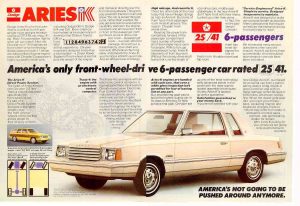
The truth is all new vehicles are overweight relative to otherwise similar-in-size vehicles of the past. This includes rivals like the Mazda CX-30 and Honda HR-V and it’s why they deliver mediocre mileage, too – even though they all have the technological advantages of port-fuel (and direct) injected engines and transmissions with multiple overdrive gears.
On the positive side of the balance sheet, the Trax’s standard transmission is not a continuously variable (CVT) automatic transmission. It is a conventional six speed automatic with gears – as opposed to the CVT’s constantly varying ranges. CVTs are in common usage to make up for the fact that modern vehicles are overweight as they can increase miles-per-gallon by (typically) about 3 MPGs overall. If cars weren’t so heavy, this would not be necessary.
The Trax’s mileage would probably be higher if it had a CVT. But then you’d have a CVT – and (eventually) a bill for a new CVT.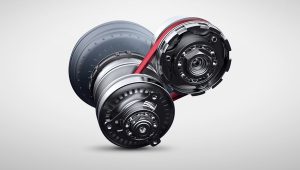
The problem with CVTs is that in order to continuously vary the range, a metal belt has to expand – and contract – within a pair of pulleys. Over time, this fatigues the metal the belt is made of until, one day, the belt breaks – and breaks the CVT. It is then time to replace the CVT.
You don’t have to worry about that with the Trax.
One more thing you won’t have to worry about is whether to buy all-wheel-drive because Chevy no longer offers this option with the Trax, which is now front-drive-only. Probably because adding AWD would bump the curb weight up to what it used to be – and decrease the MPGs along with it.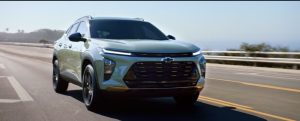
On The Road
Despite having such a small engine, the Trax moves out such that you’d think it had more engine.
And in a very real sense, it does.
The turbo attached to the 1.2 liter three stuffs as much – or more – air into the engine’s cylinders as a four could suck in (turbo boost is positive pressure; engines without turbos have negative pressure – i.e., vacuum) and the result is a more powerful combustion event when the additional air (and accompanying fuel) is burned inside those three cylinders. If the turbo is snugged right up against the exhaust ports – so that the boost builds almost as soon as the engine is revved (and gas is burned) then the turbo-boosted power comes on almost immediately.
Proof of the foregoing is how quickly this 3,000-plus pounder is capable of accelerating with only three cylinders pumping.
It helps that the Trax isn’t saddled with a CVT, too. The six speed automatic has a torque converter that amplifies an engine’s available torque by letting the engine rev to where it makes more power, which helps move the vehicle more smartly off the line. And the six speed’s shifts feel more natural than the continuous surge you get with a CVT during acceleration that can feel (and sound) like the transmission is slipping.
A manual would, of course, be even better – but it’s not available. Small crossovers used to come standard with them. But none do anymore, chiefly because they can’t be programmed for compliance – with government regulations. Automatics can be programmed to shift all the same, at the same time – and that consistency is the key to compliance. It’s the cost we pay for that, too.
Chevy includes all the latest “advanced driver assistance technology” – including a very annoying Lane Keeping system that you’ll feel through the steering wheel every time a tire touches the painted lines on either side of the travel lane. The wheel moves let – or right – to “correct” your line, even when the painted lines are skewed and your line is just fine.
The Trax also comes standard with Forward Collision Mitigation, a system that ostensibly prevents accidents that would otherwise result from a driver not paying attention to traffic and not noticing it had slowed (or stopped) in front of him. In practice, these systems often peremptorily hit the brakes when the driver is paying attention – and trying to get around a slow car ahead of him. These systems are typically programmed to consider anything closer that 3-4 car lengths as tantamount to an impending crash. In some cases, you can change the “sensitivity” to less overwrought. But it’s often – and increasingly – the case that you cannot turn these “assistance technologies” off. 
On the plus side, most of the Trax’s regularly necessary controls – like the climate controls – are still rotary knobs that can be turned by feel (and so without looking) and they are nicely canted a little toward the driver (shades of GM design past; e.g., the Pontiac Grand Prix of the late ’60s and early ’70s).
There’s also a traditional pull-it-back (and forward) gear selector rather than the trendy touch-button or rotary wheel. They’re all drive-by-wire controls now, but it’s hard to improve on the intuitive functionality of the traditional-looking (and feeling) gear selector.
The stereo’s volume is knob controlled – but to change the station and other settings you’ve got to tap the touchscreen.
Another thing to like about driving the Trax is the oversized ball-type air vents that can be used to direct the airflow almost anywhere – and a lot of it. Chevy also thought to put a slot for your phone in between the cupholders that keeps it from sliding around and keeps it upright rather than flat.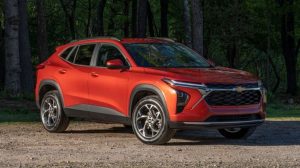
Just be careful not to slosh your coffee.
At The Curb
The ’24 Trax looks like a more substantial – a less entry level – vehicle. The increased length – now 178.6 inches vs. the previous Trax’ 167.6 inches – is chiefly responsible for this.
Being longer also means roomier.
Especially in one very important category – rear seat legroom.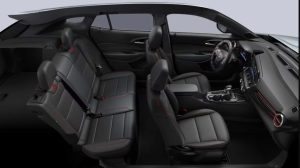
The previous Trax had just 35.7 inches of reaseat legroom. It was a tight fit for most adults. That made the old Trax a harder sell to people who needed a small crossover with room for adults in the back. Chevy has addressed this issue aggressively by increasing rearseat legroom in the ’24 Trax to 38.7 inches. That’s a full three inches more than in the old Trax and it’s a difference that’s obvious when you sit back there vs. trying to sit in the back of the old Trax. Someone my size – I’m six feet three – can sit in the back of the ’24 Trax in reasonable comfort, without having to tuck his legs or turn his knees sideways, to avoid them rubbing up against the front seatbacks.
There is also significantly more room for cargo in the ’24 – which has 25.6 cubic feet behind the back seats (vs. 18.7 before) and a total of 54.1 cubic feet with the back seats folded forward (vs. 48.4 before).
The sum and total of it is the ’24 Trax is now a compact crossover rather than a subcompact – and that makes it more than just an entry-level crossover. It makes it a family-viable entry level crossover.
Especially in view of the fact that it costs thousands less than otherwise similar compact-sized crossovers.
The Rest
Even though it is entry level, the Trax can be ordered with some higher-level equipment, including a flatscreen main gauge cluster (analog gauges are otherwise standard) a heated steering wheel, wireless phone charger and a pretty good six speaker audio system – and still cost less than half what a new entry level EV such as a Tesla 3 costs.
And the as-it-sits (base trim) Trax has all the essentials, including some additionals – such as a WiFi hot spot, LED headlights and 17 inch wheels. Like pretty much all new vehicles, the Trax comes standard with power windows and locks as well as air conditioning. Such features were luxury features (or at least, optional and extra cost features) back in the days when “entry level” meant stripped.
This entry-level crossover is just inexpensive.
The Bottom Line
While it’s true some people are spending close to $50k on a new vehicle, it’s not necessary to spend that kind of money on a new vehicle.
. . .
If you like what you’ve found here please consider supporting EPautos.
We depend on you to keep the wheels turning!
Our donate button is here.
If you prefer not to use PayPal, our mailing address is:
EPautos
721 Hummingbird Lane SE
Copper Hill, VA 24079
PS: Get an EPautos magnet or sticker or coaster in return for a $20 or more one-time donation or a $10 or more monthly recurring donation. (Please be sure to tell us you want a magnet or sticker or coaster – and also, provide an address, so we know where to mail the thing!)
If you like items like the Safety Cult T shirt pictured below, you can find that and more at the EPautos store!





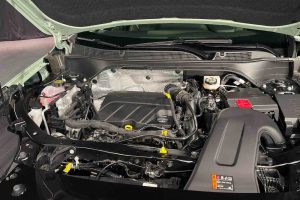







Looked, Chevy’s got an electric and non electric version of many of their models. Obviously hedging their bets, knowing that the non electric ICE vehicles are going to be the best sellers.
‘higher-level equipment, including a flatscreen main gauge cluster (analog gauges are otherwise standard)’ — eric
‘Higher-level’ is industry-speak, of course, directed to the cellphone-toting crowd which values high-res Clownscreens.
But analog gauges are tasteful and easy on the eye — the ‘higher-level’ choice of display, despite lacking some of the display modes available on its brightly-feathered, dogshit-digital counterpart.
“The wheel moves let (sic) – or right – to ‘correct’ your line…”
Not if the turn signal is used. Duh. And the wheel doesn’t move. Geeez. Steering pressure is increased slightly and one can continue the lane change without signaling. Or exclaim, Holy ship!” And move back into the lane being drifted out of. The tech doesn’t “correct” anything and shouldn’t surprise or annoy anyone paying attention.
“The stereo’s volume is knob controlled – but to change the station and other settings you’ve got to tap the touchscreen.”
There are four buttons on the front, um, back, um where your fingertips are for volume and most other settings. Stations, MP3s, etc.
I have a 2024 Trax LT, loaded, and it’s just fine. IN IT’S CLASS, just as fine, and imperfect, as my ’67 GTO, ’69 911, and… Well, let’s leave it at that.
Hi Haakon,
You know what’s “Duh”? Using the turn signal when there’s no need to – but because Big Momma says always do! Saaaaaaaaaaaaaaaaaaaaaaaaaaaaaaaaafety first!
Do you signal a lane change when you are obviously the only car on the road? I don’t. Why would I? Do you not consider it cloying to be (effectively) “corrected” by your car for not doing something it thinks you ought to do?
And you’re wrong about the steering wheel not moving left (or right). The latest systems do exactly that. I know because I test drive these damn things. The Trax’s may not be as intrusive – yet. It will be, soon.
That said, I actually liked this little unit for what it is, that being one of the few remaining economical cars on the market. I’d like to see it even more so, which it could be if Chevy were able (or willing) to sell one without all the electronica (and the air bags) and with a manual transmission.
There’s no good reason a vehicle such as this ought not to sell for around $17k.
“about the same output as the 1200 cc engine that powers this writer’s motorcycle”
That makes sense, because this is a 1193cc engine.
If it wasn’t for the tiny engine that gets crummy mileage for what it is, and will someday (well turbo) blow up, this would be a great value vehicle.
These undersized engines will put many of them in the junkyard before their time. It’s a feature, not a bug….. At least GM has a few cheap vehicles left.
This is my concern about most new cars these days, too small (boosted) engines & too heavy vehicles don’t make for a good match.
Product planners and marketing personnel in todays car companies have to be some of the dumbest on two feet. Because of the shit gas mileage of this car, it should be offered woth a manual. I doubt that there would be a mileage penalty paid. I would market it for those who would like to row their own. From what ive heard, an increasing number of young people want a stick. At least as many as in the last 10 to 15 years. Woke GM would never think of that though.
There used to be small light cars that handled really well……
1971 FIAT 128 2 Door Sedan Original MSRP $1,831….$13,915 in 2023 dollars
A recent auction price…..
1971 Fiat 128 Four-Door Sedan
Sold for $12,500 on bringatrailer on 4/30/23
The 1970s ushered in the econobox, and of all the cars that fit that descriptor, one was the true pioneer of the small cars we drive today: the Fiat 128. Although the Mini was the first popular transverse-engine, front-wheel-drive car, its gearbox was located in the engine’s sump, a less-than-ideal arrangement that has not been used since. The Fiat 128 was the Italian automaker’s first mainstream front-wheel-drive car, and its mechanical layout proved enduring, with the east-west-mounted engine driving the transmission off the driver’s side.
128 also featured such modern components as rack-and-pinion steering, front disc brakes, an independent rear suspension (with a transverse leaf spring), and a strut-type front suspension with an integral antiroll bar.
These cars had fantastic handling….40 mph corners at 80 mph…. and a great engine…the Lampredi engine is a legend….
The all-new engine, designed by Aurelio Lampredi, had an iron block, an aluminum head, and a belt-driven single overhead camshaft. It displaced 1.1 liters and produced 63 hp — not a lot, but the car weighed only about 1800 pounds.
Lampredi (the famous Ferrari engine designer) who later worked for Fiat Lancia…..Ferrari engine designer designed engine in your Fiat/Lancia, etc
Restoring a Fiat 127….
Fiat 127: Let’s save it to make a rally bomb – Davide Cironi
https://www.youtube.com/watch?v=U-PHdAt8Zq8
The famous Lampredi 4 cyl twin cam hemi (there was also a single cam version)
Ferrari engine designer designed engine in your Fiat/Lancia, etc
Fiat (Stellantis) still owns 90% of Ferrari.
Lampredi (the famous Ferrari engine designer) who later worked for Fiat Lancia designed the twin overhead cam 8 valve hemi (later on 16 valve) 4 cylinder, which powered Fiat, Lancia, Lotus 7, Morgan, Alfa Romeo, etc., He ran Abarth.
it powered more World Rally championship winners then any other engine.
One of the best race car engines in history.
One of the best 4 cyl engines in history.
The Lampredi engine was in the Lancia 037, Lancia Delta S4 and Lancia Delta Integrale, with turbo and super charger the engine put out up to 1000 hp, in race trim 600 hp.
The Lancia 037 with the Lampredi two litre engine with a super charger only, made 325 hp.
A new recreation of the Lancia 037 rally car is being produced by Kimera, (37 only, get your order in), it will have the Lampredi 4 cyl engine with turbo and super charger and will make 500 hp, weigh 2200 lb and cost $700,000. The Lampredi engine lives on. In many ways the best car in the world, better than the new hypercars, they don’t have the style or driving experience of a classic, the hypercars are too big, heavy, over computerized, self driving, boring at legal speeds, expensive. (The new Murray T50 is an exception).
The Lampredi designed Fiat Lancia 4 cyl twin cam was the most produced engine in history, it was manufactured from 1955 to 1999.
In 1952 and 1953 the Ferrari 500 F1 race car won the formula 1 championship, it was powered by the Lampredi designed 2 lt. twin cam 4 cyl engine. That F1 car had similar specs to the Lampredi powered super 7: 540 kg, 2.0 lt. Lampredi twin cam 4 cyl., 180 hp, Dedion rear axle (transaxle), 4 speed trans., tube frame chassis.
1971 FIAT 128 cost about half as much as the Trax…
the Trax has over double the HP but weighs almost twice as much…..the power to weight ratio isn’t that much different…but the Trax had to resort to a turbo….more maintenance…
The Fiat handles far better then the Trax, way more fun to drive….it is also completely analog….no computers, just a Weber carburetor, that can be rebuilt with a $35 kit and last another thirty years….the Fiat is very simple….you can work on it yourself….the Trax….very complicated…back to the dealer…lol
The Fiat also sounds better, it has a far superior engine and requires no turbo, so will last longer…..it is also far lighter so is easier on tires and brakes….
You cannot turn the Trax into a rally/track car….
After 52 years the Trax will not have almost zero depreciation…
My eldest daughter is getting her first car this winter. That is, unless Brandon’s meddling brings everything to a halt. She is looking at the dependable Corolla Hybrid, yet I will encourage her to take one of these for a test spin.
Our fleet consists of three Toyotas with high mileage and no problems. I’m so annoyed by the increasing cost of most cars, new or used, that I really don’t care as much about their reliability as much as I once did. As long as it has a warranty and no CVT.
I would continue with the Toyotas.
On the plus side, this is imported from Korea, so the UAW isn’t involved.
And while everyone would consider this underpowered today, it would have been amazing back when I started driving and my Sunbird had 85hp, and my friends Grand Am had 95hp. It was a luxury to get into my parents Pontiac 6000 with a V6 and have something like 120hp, and only weighed 200 lbs less than this Trax.
I agree, Nate –
Because it’s a fact. This little Chevy is quicker to 60 than a 1980 Turbo Trans-Am, which took 9-10- seconds to make the run. And it was a “performance” car. With a 4.9 liter V8!